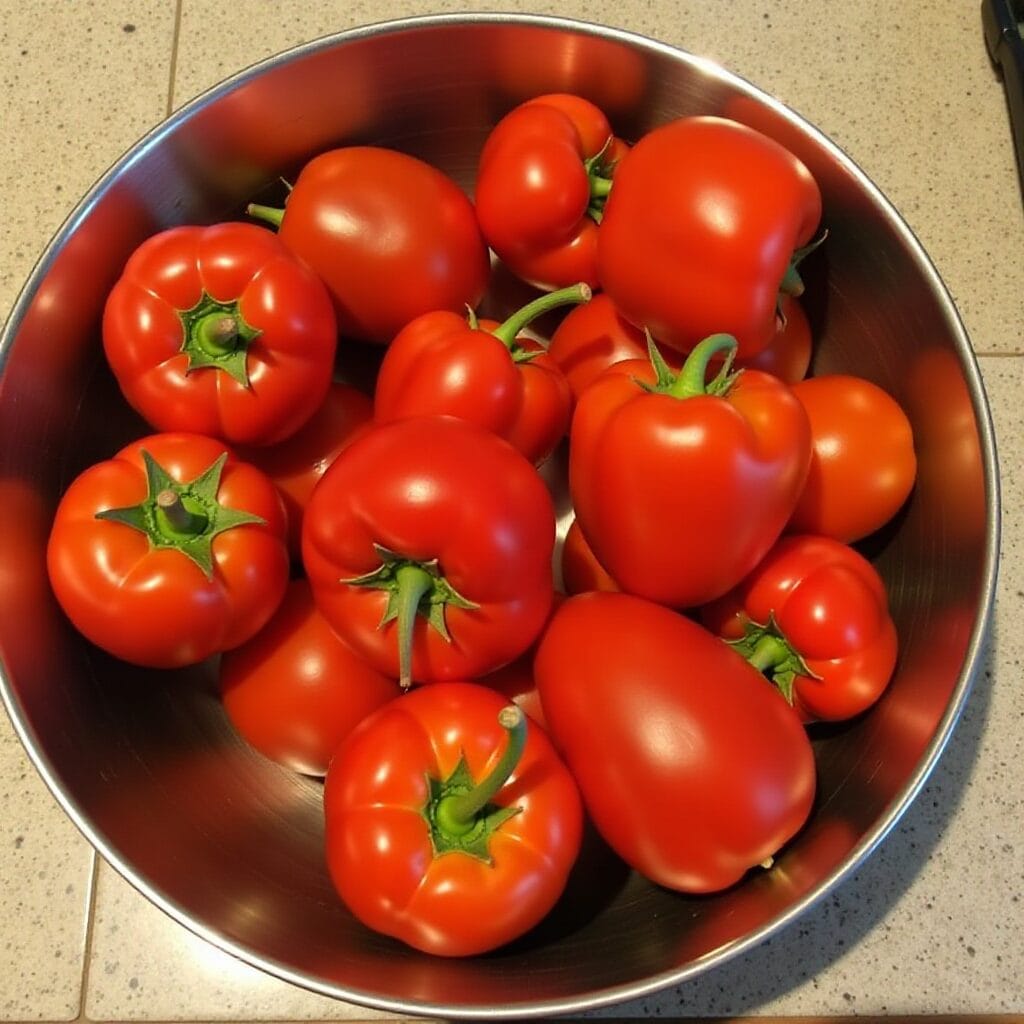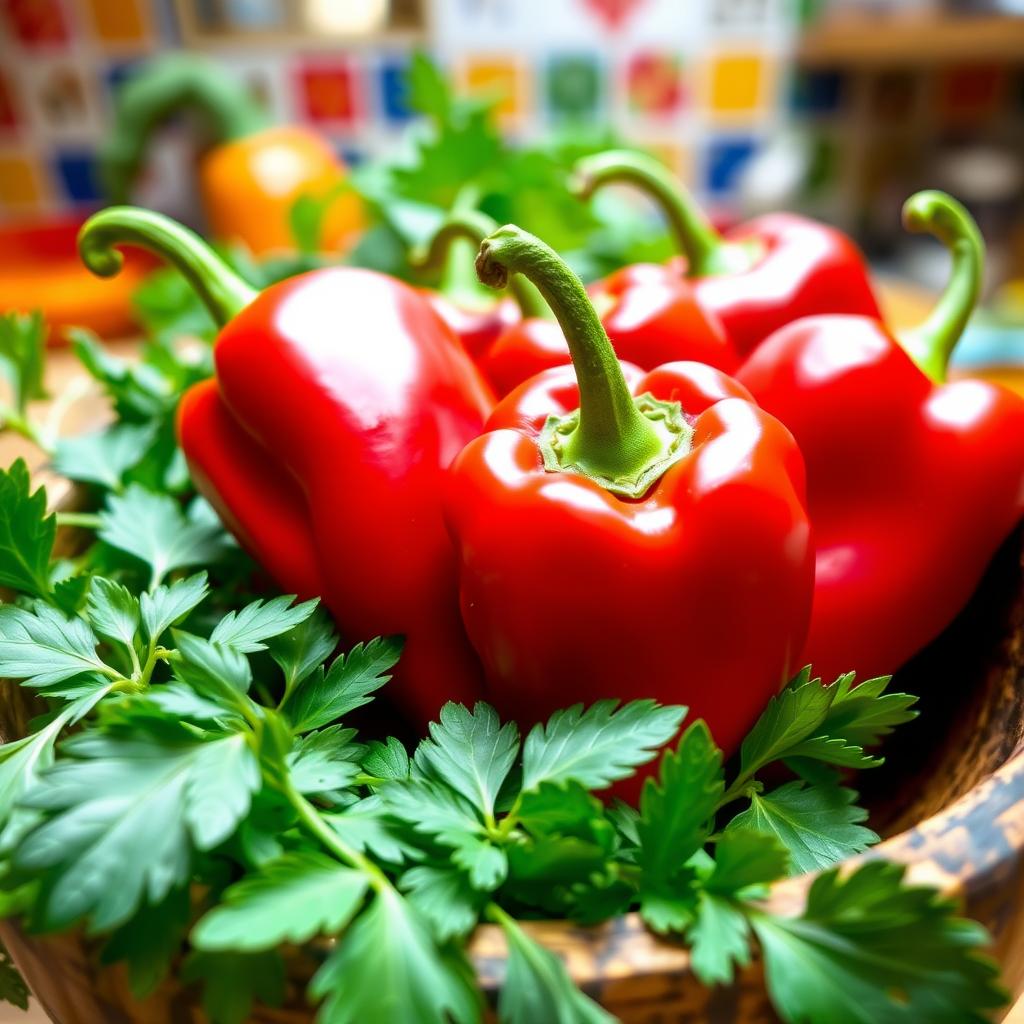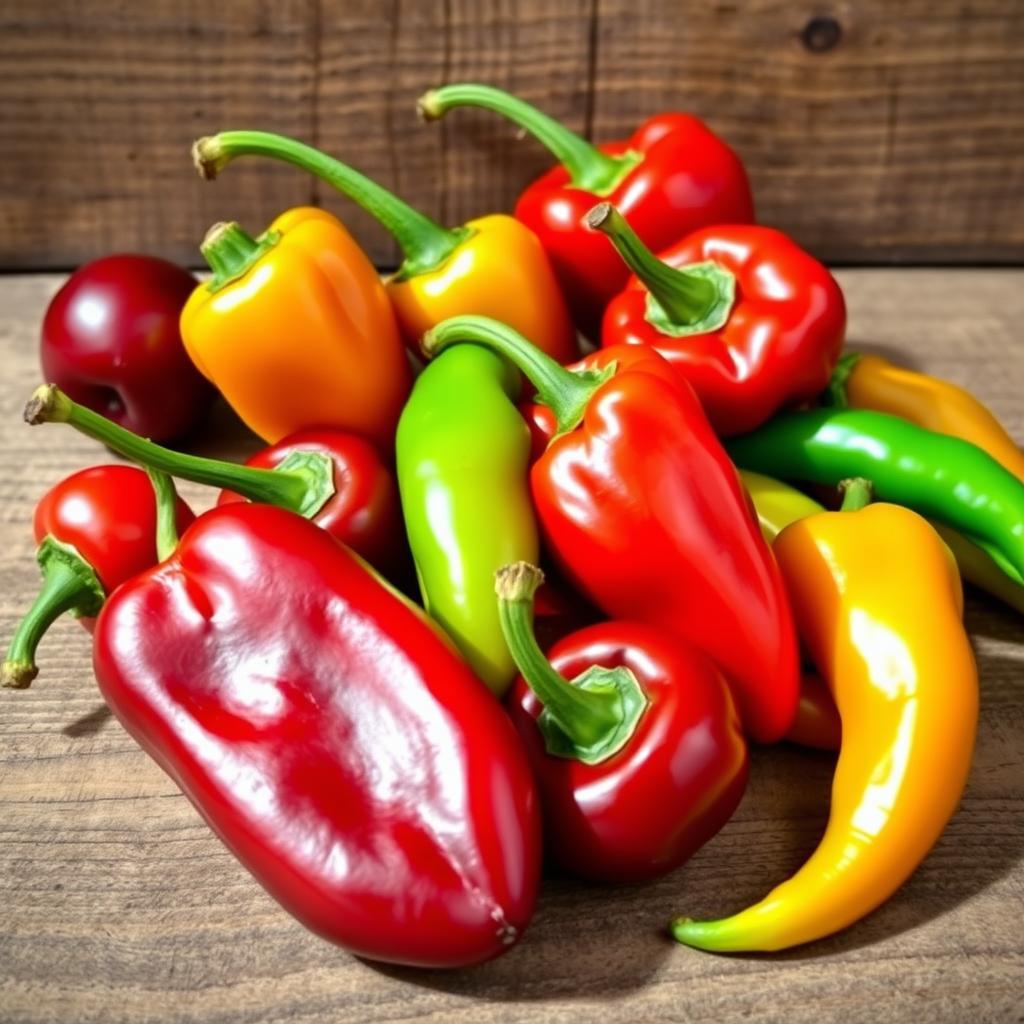I love exploring the world of peppers, from the hot habanero to the sweet bell pepper. Today, I’m diving into the differences between hot cherry peppers and Peppadew. Are they the same, or do they have their own special traits? Let’s find out together as we explore these tasty peppers.
Key Takeaways
- Discover the key differences between hot cherry peppers and Peppadew peppers in terms of physical characteristics, origin, and culinary uses.
- Explore the history and origins of the Peppadew brand, a unique South African pepper variety.
- Understand the variations in heat levels and flavor profiles between these two distinct pepper types.
- Learn about the nutritional benefits and culinary applications of both hot cherry peppers and Peppadew peppers.
- Discover where to source quality peppers and even learn how to grow your own at home.
Understanding Hot Cherry Peppers and Peppadew: Key Differences
In the world of pepper varieties, hot cherry peppers and Peppadew peppers stand out. They look similar at first glance but have many differences. These global pepper varieties are unique in their own ways.
Physical Characteristics and Appearance
Hot cherry peppers are small and round, like cherries. They can be bright red or deep burgundy, with a shiny skin. Peppadew peppers, however, are pear-shaped and have a bumpy texture. They can be yellow-orange or reddish-orange.
Origin and Growing Regions
Hot cherry peppers come from places like Mexico, Central America, and the Mediterranean. They grow well in warm places. Peppadew peppers, on the other hand, come from South Africa’s Limpopo province. They were first grown there and then introduced worldwide.
Common Uses in Cuisine
Hot cherry peppers and Peppadew peppers are used in different ways in cooking. Hot cherry peppers add a bold, sweet heat to dishes like salsas and roasted peppers. Peppadew peppers, with their sweet-and-spicy taste, are great in salads, sandwiches, and on pizzas.

The History and Origins of Peppadew Brand Peppers
The Peppadew brand has a fascinating story. It started in South Africa with the discovery of a unique pepper variety in the late 1990s. This chance find led to the creation of the Peppadew pepper, loved by chefs and food lovers worldwide.
Years of hard work went into perfecting the Peppadew pepper. They focused on its sweet taste and mild heat. This made them a great addition to many dishes.
“The Peppadew pepper is a true culinary gem, with a captivating story that mirrors its exceptional taste and versatility.”
Now, Peppadew peppers are enjoyed everywhere. Their unique flavor and bright color are a hit in kitchens and restaurants. The brand’s dedication to quality and new ideas has made it a favorite among gourmet pepper fans.

The Peppadew brand keeps growing and showing off the beauty of global pepper varieties. Its special history and taste make it a culinary icon. It inspires chefs to try new things with these amazing peppers.
Traditional Hot Cherry Peppers: A Detailed Look
Traditional hot cherry peppers are a standout in the cherry pepper varieties world. They add a spicy kick to dishes and have unique growing needs. They also offer nutritional benefits.
Growing Conditions
Hot cherry peppers love warm, well-drained soil and full sun. They grow well in many soils, as long as the soil is slightly acidic. The soil pH should be between 6.0 and 7.0.
These peppers need consistent moisture but avoid waterlogged soil. Too much water can cause root rot and other problems.
Harvesting and Processing
It’s important to know when to pick hot cherry peppers for the best pepper heat levels and taste. They’re ready when they’re deep red, yellow, or orange. Handling them carefully during harvest is key to avoid damage.
After picking, you can pickle, dry, or freeze them. Each method changes the flavor and texture of the peppers.
Nutritional Content
Hot cherry peppers are not just tasty but also full of nutrients. They’re rich in vitamin C, which boosts the immune system. They also have vitamins A and K, and capsaicin, which gives them heat.
Understanding how to grow, harvest, and eat hot cherry peppers can enhance your cooking. Adding these flavorful peppers to your dishes can make them more exciting.
Are Hot Cherry Peppers the Same as Peppadew?
Hot peppers like hot cherry peppers and Peppadew peppers look similar. They are small, round, and very spicy. But, they are not the same.
Hot cherry peppers come from the Mediterranean and Latin America. Peppadew peppers, on the other hand, were created in South Africa. This makes their tastes and how they grow different.
| Characteristic | Hot Cherry Peppers | Peppadew Peppers |
|---|---|---|
| Shape | Rounded, with a slight point | Rounded, with a more pronounced point |
| Color | Bright red to deep burgundy | Bright yellow-orange |
| Heat Level | Moderately hot, ranging from 2,500 to 5,000 Scoville units | Mild to medium heat, around 1,500 to 2,200 Scoville units |
| Flavor | Robust, with a balance of sweetness and heat | Sweet, with a slightly tangy undertone |
Hot cherry peppers and Peppadew peppers may look alike, but they are different. Knowing this helps you pick the right pepper for your dish.
“The key to unlocking the full potential of these peppers lies in recognizing their unique characteristics and how they can complement different culinary creations.”
Comparing Heat Levels: Scoville Scale Rankings
Exploring the world of hot peppers, knowing the Scoville scale is crucial. It helps us see the heat levels of hot cherry peppers and Peppadew peppers. This scale, created by Wilbur Scoville in 1912, measures the heat of chili peppers by their capsaicin content.
The hot cherry pepper usually has a Scoville Heat Unit (SHU) rating of 2,500 to 5,000. This puts it in the “moderately hot” category. On the other hand, Peppadew peppers have a rating of 1,000 to 2,500 SHU. This makes them slightly milder than hot cherry peppers in pepper heat levels.
| Pepper Variety | Scoville Heat Units (SHU) | Heat Level |
|---|---|---|
| Hot Cherry Peppers | 2,500 – 5,000 SHU | Moderately Hot |
| Peppadew Peppers | 1,000 – 2,500 SHU | Mild to Moderate |
This hot pepper comparison shows the subtle differences in spiciness between these two peppers. It helps you choose the right pepper for your dishes.
“Understanding the Scoville scale is like holding the key to the spice cabinet of the culinary world.”
Flavor Profiles and Taste Characteristics
Hot cherry peppers and Peppadew peppers have unique pepper flavor profiles. Their sweetness, spiciness, texture, and aftertaste make them special. These chili pepper types offer distinct experiences.
Sweet vs. Spicy Notes
Hot cherry peppers mix sweet and spicy flavors well. They have a moderate heat but are mostly sweet. This balance makes them taste great.
Peppadew peppers are very sweet with a mild spice. Their sweetness is enhanced by fruity undertones.
Texture Differences
The texture of these peppers affects their taste. Hot cherry peppers are crisp and crunchy. This adds to their freshness.
Peppadew peppers are softer and more tender. This is especially true when they’re pickled. They feel juicy and delicate.
Aftertaste Comparison
The aftertaste of hot cherry peppers is intense and memorable. It builds up slowly. Peppadew peppers, on the other hand, have a clean aftertaste. It’s sweet and fades quickly.
Exploring the flavor profiles of these peppers opens up new culinary possibilities. It lets you try different tastes and use these ingredients in new ways.
| Characteristic | Hot Cherry Peppers | Peppadew Peppers |
|---|---|---|
| Sweetness | Moderate, well-balanced | Pronounced, fruity |
| Spiciness | Moderate heat level | Mild, complementary |
| Texture | Crisp, crunchy | Soft, tender |
| Aftertaste | Lingering heat | Clean, subtle sweetness |
“The complexity of flavor in these peppers is truly captivating, offering a sensory journey that tantalizes the taste buds.”
Culinary Applications and Recipe Uses
Hot cherry peppers and Peppadew peppers are very versatile. They can make many dishes better. They add flavor and excitement to your cooking.
One great way to use them is in pickled peppers recipes. The tangy brine goes well with the peppers’ heat and taste. They’re great in sandwiches, salads, and as a snack. Try pickling cherry peppers in vinegar, sugar, and spices for a quick snack.
Hot cherry peppers and Peppadew peppers also work well in savory dishes. They add flavor to pasta sauces, pizza, and deviled eggs. Stuff them with cheese or roast them to enhance their sweetness.
| Dish | Recommended Pepper | Suggested Use |
|---|---|---|
| Grilled Cheese Sandwich | Peppadew Peppers | Slice and add to the sandwich for a sweet and spicy twist |
| Taco Salad | Hot Cherry Peppers | Finely chop and sprinkle on top of the salad for a crunchy, spicy kick |
| Roasted Vegetable Medley | Both | Toss with the vegetables before roasting for added flavor |
Using hot cherry peppers and Peppadew peppers in your cooking opens up endless possibilities. Try different recipes and find new ways to enjoy their unique flavors and textures.
Preservation Methods: Pickling and Storage
Keeping the flavors and textures of hot cherry peppers and Peppadew peppers fresh is key. Pickling and proper storage are two main ways to do this. They help you enjoy these veggies all year long.
Traditional Pickling Techniques
Pickling is a classic method for preserving pickled peppers. It involves soaking the peppers in a brine. This brine is made with vinegar, salt, and spices. It keeps the peppers fresh and flavorful.
Here’s how to pickle peppers the traditional way:
- Clean and prepare the peppers, removing stems and cutting them as needed.
- Make a pickling brine by heating vinegar, salt, and spices like garlic or dill.
- Put the peppers in sterilized jars, leaving some space at the top.
- Pour the hot brine over the peppers, making sure they’re covered.
- Seal the jars and let them cool before refrigerating or storing in a cool, dark place.
Storage Guidelines
Storing pickled peppers right is just as important as pickling them. Here are some tips for keeping hot cherry peppers and Peppadew peppers fresh:
- Fresh peppers: Keep them in the fridge, unwashed and whole, for up to 1 week.
- Pickled peppers: Store them in sealed jars in the fridge for months. They’ll stay crisp and flavorful.
- Frozen peppers: Freeze whole or sliced peppers for up to 12 months. This is great for longer storage.
Learning to pickle and store peppers well lets you enjoy their flavors all year. It’s a great way to keep your taste buds happy.
Health Benefits and Nutritional Comparison
Hot cherry peppers and Peppadew peppers are more than just tasty. They are full of vitamins, minerals, and compounds that are good for you. These chili peppers can really help your health.
Both hot cherry peppers and Peppadew peppers are rich in vitamin C. You get over 100% of your daily need in just one serving. Vitamin C boosts your immune system and keeps your skin healthy. They also have vitamin A, which is great for your eyes and helps cells grow.
These peppers are also packed with potassium and manganese. Potassium helps control blood pressure and is good for your heart. Manganese is important for metabolism and bone health.
The spicy heat in these peppers comes from capsaicin. Capsaicin can improve blood flow, help with pain, and even aid in weight loss.
| Nutrient | Hot Cherry Peppers (per 100g) | Peppadew Peppers (per 100g) |
|---|---|---|
| Vitamin C | 143% DV | 117% DV |
| Vitamin A | 32% DV | 28% DV |
| Potassium | 276mg | 215mg |
| Manganese | 0.4mg | 0.3mg |
| Capsaicin | Medium-High | Mild-Medium |
Hot cherry peppers and Peppadew peppers are full of nutrients and compounds. They are great for your health and taste amazing.
Where to Buy and How to Select Quality Peppers
Finding the perfect Peppadew brand or cherry pepper varieties is a fun journey. You can find them at your local store or specialty markets. Here are some tips for picking the best peppers.
Shopping Tips
- Look for trusted suppliers known for fresh, tasty produce. Online specialty retailers are great for rare pepper types.
- Choose peppers that are firm, bright, and have no blemishes. Stay away from shriveled or discolored ones.
- For loose peppers, pick ones that are the same size and shape. This helps with cooking and looks.
- When buying jarred or canned Peppadew brand peppers, check the expiration date. Make sure the packaging is sealed and undamaged.
Quality Indicators
To get the best cherry pepper varieties, look for these signs:
- Bright, glossy skin without wrinkles or blemishes
- Firm, crisp texture that snaps when gently squeezed
- Vibrant, even color all over the pepper
- Pleasant, aromatic scent that shows the pepper’s flavor
| Quality Indicator | What to Look For |
|---|---|
| Appearance | Bright, glossy skin without blemishes or discoloration |
| Texture | Firm, crisp consistency that snaps when gently squeezed |
| Color | Vibrant, even hue throughout the pepper |
| Aroma | Pleasant, aromatic scent that hints at the pepper’s flavor |
By following these tips and indicators, you’ll find the tastiest and most versatile Peppadew brand and cherry pepper varieties for your dishes.
Growing Your Own: Garden Tips and Requirements
If you love hot cherry peppers or Peppadew, why not grow them in your garden? With the right care, you can harvest these tasty pepper varieties from your backyard.
To grow pepper varieties, they need lots of sunlight, good soil, and steady water. These global pepper varieties love warm, frost-free places. So, plant them at the right time.
- Choose a sunny spot in your garden for at least 6-8 hours of direct sunlight.
- Make the soil better with compost or well-rotted manure for good drainage and nutrients.
- Plant the pepper seedlings or seeds after the last frost in your area. Space them 18-24 inches apart.
- Water the plants often to keep the soil moist but not too wet.
- Use stakes or cages to support the plants as they grow. This keeps the fruits off the ground.
Picking your peppers is a fun part of growing them. Peppers are ready when they’re the right size and color, usually deep red or bright yellow-orange.
“Growing your own peppers is a rewarding experience that allows you to enjoy the unique flavors and heat profiles of different pepper varieties right from your garden.”
With some planning and care, you can grow hot cherry peppers or Peppadew in your garden. Enjoy the fresh, flavorful results all season.
Conclusion
Hot cherry peppers and Peppadew peppers are unique in their own ways. They both add a zesty kick to dishes, but they differ. Hot cherry peppers are known for their intense heat and earthy taste. Peppadew peppers, on the other hand, have a sweet-and-spicy flavor and a crunchy texture.
Whether you love the fiery taste of hot cherry peppers or the sweet-and-spicy of Peppadew, there’s a place for each in gourmet cooking. Try both to see which one you prefer. Knowing the differences between them lets you use these peppers to their fullest in your recipes.
The world of peppers is vast and exciting. Start a flavor journey to learn more about hot cherry peppers and Peppadew. They are both favorites in cooking for good reasons.

